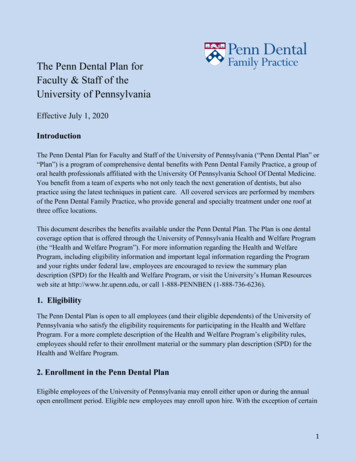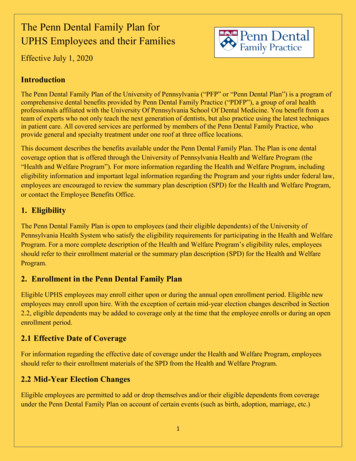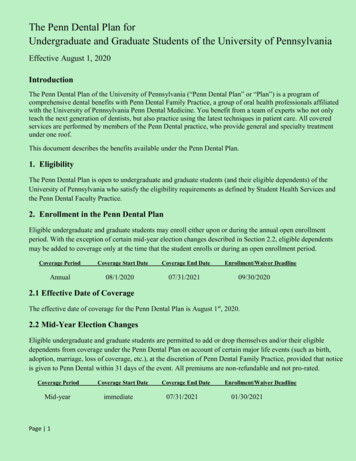
Transcription
The Penn Dental Plan forFaculty & Staff of theUniversity of PennsylvaniaEffective July 1, 2020IntroductionThe Penn Dental Plan for Faculty and Staff of the University of Pennsylvania (“Penn Dental Plan” or“Plan”) is a program of comprehensive dental benefits with Penn Dental Family Practice, a group oforal health professionals affiliated with the University Of Pennsylvania School Of Dental Medicine.You benefit from a team of experts who not only teach the next generation of dentists, but alsopractice using the latest techniques in patient care. All covered services are performed by membersof the Penn Dental Family Practice, who provide general and specialty treatment under one roof atthree office locations.This document describes the benefits available under the Penn Dental Plan. The Plan is one dentalcoverage option that is offered through the University of Pennsylvania Health and Welfare Program(the “Health and Welfare Program”). For more information regarding the Health and WelfareProgram, including eligibility information and important legal information regarding the Programand your rights under federal law, employees are encouraged to review the summary plandescription (SPD) for the Health and Welfare Program, or visit the University’s Human Resourcesweb site at http://www.hr.upenn.edu, or call 1-888-PENNBEN (1-888-736-6236).1. EligibilityThe Penn Dental Plan is open to all employees (and their eligible dependents) of the University ofPennsylvania who satisfy the eligibility requirements for participating in the Health and WelfareProgram. For a more complete description of the Health and Welfare Program’s eligibility rules,employees should refer to their enrollment material or the summary plan description (SPD) for theHealth and Welfare Program.2. Enrollment in the Penn Dental PlanEligible employees of the University of Pennsylvania may enroll either upon or during the annualopen enrollment period. Eligible new employees may enroll upon hire. With the exception of certain1
mid-year election changes described in Section 2.2, eligible dependents may be added to coverageonly at the time that the employee enrolls or during an open enrollment period.2.1 Effective Date of CoverageFor information regarding the effective date of coverage under the Health and Welfare Program,employees should refer to their enrollment materials of the SPD from the Health and WelfareProgram.2.2 Mid-Year Election ChangesEligible employees are permitted to add or drop themselves and/or their eligible dependents fromcoverage under the Penn Dental Plan on account of certain events (such as birth, adoption, marriage,etc.) provided that notice is given to the Benefits Office within 30 days of the event. You must reportthe event online via the University of Pennsylvania enrollment website at www.upenn.edu/u@penn(click on “health benefits—view, enroll, change”, under Benefits) or call the Penn Benefits Center at1-888-PENNBEN (1-888-736-6236). More information about change in status events can be foundin the SPD for the Health and Welfare Plan.3. Schedule of BenefitsThe Penn Dental Plan provides the following coverage for the fiscal year which starts July 1 andends on June 30:Type I Services – 100% Coverage Diagnostic and Preventive, including routine examinations and prophys/cleanings (limited tonot more than two times in a fiscal year July 1 through June 30), radiographs (excludingCBCT), oral hygiene counseling, fluoride applications and sealants (for children up to andincluding age 14), sealants covered (2) times in 14 fiscal years on permanent molars only,excluding wisdom teeth.Type II Services – 80-100% Coverage Basic restorations: Amalgam (silver-colored restorations) for back teeth and Composites(tooth-colored restorations) for front teeth are covered at the 100% rate. Composites for backteeth are subject to co-pay of 20%. Coverage is contingent upon radiographic evidenceshowing the need for restorations for non-cosmetic purposes.2
Oral surgery (out of hospital only) including extractions, incision and drainage of abscesses,alveolectomy, and alveoloplasty, removal of oral cysts and tumors, and other routine oralsurgical procedures performed in the office are covered at 100%. The aforementionedservices shall be covered by the Penn Dental Plan only if such services are not covered by thesubscriber’s medical coverage. The Plan covers fully and partial bony impacted third molarsand the directly related diagnostic expenses, only if denied in full by any and all medicalcoverage. Coordination of benefit rules apply and shall not exceed 100% of the treatmentcost.Emergency treatment (palliative treatment for the relief of pain or discomfort) covered at100%. Other services performed during emergency treatment will be covered at their usualbenefit levels.Type III Services – 80% Coverage Periodontics: Surgical and non-surgical periodontics including subgingival curettage, scalingand root planning, periodontal maintenance.Endodontics, including pulp treatment, root canal therapy, pulpotomy, and apicoectomy.Type IV Services – 60% coverage Major restorations: including inlays, crowns (when necessary due to decay or fracture), andbridges.Dentures, including complete upper and/or lower dentures, partial dentures, and relining andrepair of dentures.Space maintainers—prosthetic devices used in children to maintain the gap created by amissing tooth until the permanent tooth emerges.Please refer to the Limitations and Exclusions section.Type V Services – 60% coverage Orthodontics: includes one orthodontic treatment per lifetime for children and adults.Indications for orthodontics are an overbite of at least four millimeters, a crossbite, orprotrusive or retrusive relationship of at least one cusp. Transfer of subscribers undertreatment will be subject to a monthly treatment fee, which will be covered at the 60% level.Subscribers in treatment when their Penn Dental Plan coverage is no longer in effect willhave their orthodontic benefit prorated by the time remaining in treatment, subject to a 2,000 lifetime maximum benefit. Invisalign is included in this orthodontic benefit, subject to the 2,000 lifetime maximumbenefit. Subscribers must be a candidate for Invisalign as determined by Penn Dental.3
The orthodontic benefit will be applied towards the annual maximum Plan benefit of 3,000.Type VI Services – 50% coverage Implants: surgery including restoration. Restorations on implants, including crowns and otherprostheses, are covered at the usual level for that restoration. The implant abutment (postthat is placed in the implant fixture and anchors the crown), bone graft, and any otherbiological materials are excluded from coverage. The Plan will only cover crown restorationsfor implants that were placed at Penn Dental. Please refer to the Limitations and Exclusionssection. The annual maximum benefit for implant surgery is 3,000. This implant benefit willbe applied to the annual maximum Plan benefit of 3,000.Occlusal Nightguards (processed in an outside laboratory or at Penn Dental) limited to 1 in 5years.CT Scans for dental procedures (when scanned at Penn Dental).Cosmetic – includes, veneers, microabrasion, and bonding. Fillings performed for cosmeticpurposes (closing a space, fixing a chip, etc.) are limited to the cosmetic benefit of 50%.Bleaching is excluded from the cosmetic benefit (in FY15 the fee for bleaching wassignificantly reduced to result in lower overall patient co-pay).3.1 EmergenciesEmergency care is provided for subscribers of the Penn Dental Plan on a 24-hour basis. If anemergency occurs outside of normal business hours, the subscriber should call (215) 898-PDFP(7337) or any Penn Dental office for a referral to the emergency provider on call.3.1.1 Out-of-the-Area Emergency CareIn the event that an emergency occurs when the subscriber is more than 100 miles away from one ofthe Penn Dental offices, palliative treatment (treatment to alleviate the immediate discomfort) from anon-plan dentist is covered by the Penn Dental Plan at our normal rate of coverage. Examples ofemergencies are pain, fever, swelling, bleeding, or loss of a tooth.Treatment from a non-plan dentist should be limited to palliative treatment. Follow-up care must beprovided by Penn Dental in order to be covered.To receive reimbursement from the Penn Dental Plan for palliative treatment, the subscriber mustsubmit an itemized bill with procedure codes and receipt of payment from the dentist who providedthe emergency treatment. If x-rays were taken, they must also be included or forwardedelectronically.4
The subscriber is responsible for all out of pocket expenses incurred for the emergency caretreatment. The subscriber shall receive reimbursement from the Penn Dental Plan for the palliativeemergency services at a rate equal to the Penn Dental fee for the same or similar service, subject tothe Plan coverage and limitations. The subscriber is responsible for any fees charged by the dentistwho provided emergency treatment that are in excess of those charged by Penn Dental.3.2 Limitations and ExclusionsThe maximum annual benefit per plan year (July 1-June 30) for each family member is 3,000.The Penn Dental Plan will NOT cover: An appliance or modification of one, where an impression was made before the subscriberwas covered.Root canal therapy if the pulp chamber was opened before the subscriber was covered.Fixed prosthetics (including implants) and full or partial denture at any stage of fabricationprior to coverage. In the case of out-of-area emergency treatment for these partiallycompleted procedures, coverage is subject to the approval of the Clinical Director.Other procedures not covered by the Penn Dental Plan include, but are not limited to, the following: Services, procedures, or supplies not provided by Penn Dental, except for emergencyservices covered in Section 3.2.1.Services provided under any government program or law under which the individual is, orcould be, covered as determined by the Penn Dental Plan Administrators.Coverage for a restoration (bridge, crown, removable denture or implant) of a tooth or teethmissing or extracted prior to enrollment in the Penn Dental Plan is subject to the approval ofthe Clinical Director and may be denied.Unserviceable appliances that meet all of the other criteria for replacement will be replacedby same-type appliances or an alternative benefit for enhanced prosthetic choices can beapplied at the discretion of the Penn Dental Plan Administrator.Replacement or upgrade of a previous restoration (bridge, crown, removable denture ofimplant) that is less than 60 months old. If the restoration was not performed in one of thePenn Dental offices, the subscriber is responsible for obtaining documentation of therestoration’s age.For implants that were placed by Penn Dental within the past five years, the Plan will notcover a removable partial denture placed in the same immediate area.Occlusal appliances, other than for bruxism or any occlusal guard that is less than 5 yearsold.Procedures necessary to alter the vertical dimension or to restore occlusion by splinting.Splinting teeth with permanent restorations (crowns) for periodontal purposes.5
Services necessitated by an accident related to employment or disease covered under theworkers’ compensation or similar law.Abutments, bone grafts and biological materials, such as membranes, for dental implants(which must be paid for before delivery of such materials).Prosthetic superstructure over implants (crowns, bridges, attachments, dentures) if theimplant itself was not covered under the Penn Dental Plan.Replacement of lost or broken orthodontic appliances.Oral surgery and related expenses performed in a hospital.Whitening procedures.Dentistry requiring hospitalization. Once approved by the Clinical Director Penn DentalPlan benefits will be applied to preauthorized pediatric dentistry at the normal Penn DentalPlan rates.General anesthesia—Conscious (IV or Oral) sedation—for dentistry services (i.e. fillings,extractions, etc). For complex extractions, Penn Dental will submit general anesthesiaservices to your medical carrier for consideration of benefits.Treatment of temporomandibular (TMJ) dysfunction. No TMJ appliances.A service provided while the subscriber’s coverage is not in effect, except as provided underSection 5.1.Nitrous oxide.Preventive sealants on adults are not covered. Sealants are covered to age 14 only and arelimited to coverage 2 times in 14 fiscal years on permanent molars only and exclude wisdomteeth.Fluoride treatments subscribers 15 years of age or older.Oraquix (needle-free anesthetic) tissue anesthesia.Whitening procedures.4. Cost of ServicesSubscribers are expected to pay their share of the cost of services, if any, at the time of their visit.Arrangements can be made with the billing staff for individual payment plans, such as those forcrown and bridge treatment and orthodontics.6
4.1 Employee ContributionEmployees should refer to their enrollment materials for information on what, if any, employeecontribution is required for coverage under the Penn Dental Plan. Contributions are deducted frompay before any federal income tax; FICA (Social Security) tax and Medicare Insurance tax arewithheld. The state tax treatment will differ from state to state. There are exceptions to the pre-taxstatus of your contributions for a same-sex partner and a partner’s child(ren) who are not your taxdependents. See the SPD for the Health and Welfare Plan for more information about these specialsituations.5. Termination of CoverageIn general, coverage for the subscriber and family members will terminate if the subscriber ceases tobe an eligible employee of the University of Pennsylvania or if the Penn Dental Plan is discontinuedby the University of Pennsylvania. More detailed information about when and how coverage underthe Dental Plan may end is set forth in the SPD for the Health and Welfare Plan.5.1 Extension of BenefitsIf coverage under the Penn Dental Plan is terminated for the subscriber or a family member, theprotection will be extended to cover treatment in progress or basic services received within the next30 days provided that these services would have been covered had the Penn Dental Plan remained ineffect. Payment for treatment received after this extension period will be on a fee-for-service basis.6. Subscriber ResponsibilitiesSubscribers to the Penn Dental Plan are expected to: Seek all dental care from Penn Dental Family Practice (this Plan is not accepted at PennDental Medicine student clinics).Pay deductibles and their co-payments for covered services at the time of the visit.Notify the Benefits Office of any changes in status affecting covered dependents.Request treatment plan recommendations in a printed format.Give at least 24 hours’ notice for cancellation of appointments. If a subscriber or his/herdependents fail to give advance notice (minimum 24 hours), a letter will be sent notifying thesubscriber that future failed or broken appointments (less than 24 hours) will generate a fee.This fee will increase with future failed or broken appointments. Subscribers must pay all7
failed or broken appointment fees before scheduling future appointments for dentaltreatment.Notify their provider at their next appointment of any changes in medical history, includingmedications or any other changes such as address changes.Be present for the entire visit when a minor child is having dental treatment and sign atreatment plan for the child.Be on time for all appointments.Maintain good dental health habits.7. Changes in Family StatusNotify the Benefits Office of any changes in family status affecting covered dependents.8. Coordination with Other PlansThe Penn Dental Plan contains a provision that coordinates the benefits it pays on behalf of anindividual with payments that may be made under other plans covering the individual so that thetotal benefits available will not exceed 100% of the allowable expenses.An allowable expense is any necessary, reasonable, and customary expenses covered, at least in part,by one of the “plans.” For this purpose, the terms “plans” refer to the following types of medical anddental care benefit programs: (a) coverage under a government program or coverage required bystatute, including no-fault coverage to the extent required in policies or contracts by a motor vehicleinsurance statute or similar legislation; and (b) group insurance through employment or othercoverage obtained through an educational institution above the high school level.When a claim is made, the primary plan pays its benefits without regard to any other plans. Thesecondary plans adjust their benefits so that the total benefits available will not exceed the allowableexpenses. The Penn Dental Plan will not pay more than it would have paid if there were no otherplan. A plan without a coordination provision is always the primary plan. If all plans have acoordination provision, the plan covering the subscriber directly, rather than as a dependent, is theprimary plan. If both parents cover a dependent child, except for situations where the parents areseparated or divorced, the plan of the parent whose date of birth (month, day) falls earlier in thecalendar year is the primary plan for that child. If both parents have the same birth date, the plan thatcovered the parent longer shall be primary.8
9. Statement of Rights of the UniversityAs with any other coverage option provided under the Health and Welfare Plan, the University(acting through its Vice President for Human Resources) reserves the right to amend or terminate thePenn Dental Plan, in whole or in part, at any time.10. Resolution of Questions Regarding Services and BillingIf a subscriber believes that he/she has not been provided with sufficient information about the PennDental Plan or has been denied a benefit under the Penn Dental Plan, the subscriber may file awritten claim with:Penn Dental Plan Administrator240 S. 40th StreetSchattner Building-Suite 300Philadelphia, PA 19104askPDFP@dental.upenn.eduDetailed information about filing claims and appealing denied claims for benefits under the PennDental Plan is set forth in the SPD for the Health and Welfare Plan.Plan YearThe Plan year begins each July 1st and ends June 30th.9
Once approved by the Clinical Director Penn Dental Plan benefits will be applied to preauthorized pediatric dentistry at the normal Penn Dental Plan rates. General anesthesia—Conscious (IV or Oral) sedation—for dentistry services (i.e. fillings, extractions, etc). For complex extractions, Penn Dental will submit general anesthesia










